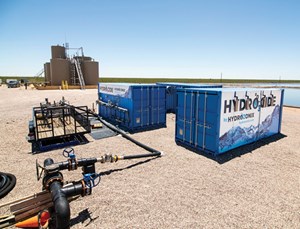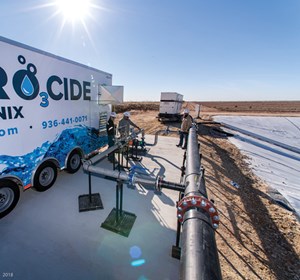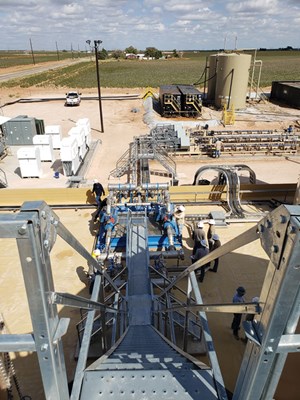The art of a water midstream deal
Oilfield water midstream companies are the fastest-growing segment of the oil and gas sector today. An industry that is projected to grow significantly over the next few years. IHS Markit, Woods Mackenzie, Rystad Energy and Raymond James all predict big growth for produced water management. And with that growth, we’ve already seen big investments in the water midstream sector.
We’ve seen Goodnight Midstream have a purchase fall through, only to have Tailwater triple its investment in the firm. We’ve seen Singapore’s GIC make an investment in WaterBridge, giving it a $2.89-billion valuation. Even more recently, we’ve seen the purchase of Oilfield Water Logistics for $489 million. What makes this remarkable is it is happening within a larger oil and gas industry that has watched the investment community back away from it.
Investors are skittish about a floundering oil price, concerns over well interference, and declining production, not to mention climate change lawsuits. Money for drilling and completions is drying up, and we’re seeing service companies begin layoffs. The beam of light shining through the black clouds of the oil and gas industry is oilfield water management, and the real shining star there is the water midstream.
THE ART OF THE DEAL
Think Big. There are some important aspects in the book, The Art of the Deal, that have great relevance to the water midstream. One of the key points in the book is “Think Big.” Well that’s what is part of the value of the water midstream, providing scale. This scale helps reduce cost, reduce trucking by supplying pipelines, and improve safety.
Total Focus. Another lesson in the book is “Total Focus.” What is rumored to have resulted from TPG pulling out of its acquisition of Goodnight Midstream was the lack of focus on the Permian basin. If you’re a water midstream, you should be focusing on where you plan on building scale.
Get Great People. The water midstream space is getting crowded. An important way to differentiate yourself in this crowded field is with top-notch talent—not just your executive team, but your operations team. This will be the key to who the winners are within the water midstream sector. Getting the right team to develop and execute your vision isn’t easy, but it will separate the winners from the also-rans.
Get Leverage: Provide Something Others Want. While access to capital is important, providing something that others want for water midstream companies is about reliability, safety record, operational efficiency and, ultimately, trust.
Deliver the Goods. Now think track record, operational record and reputation. Do you deliver on schedule and under budget? What about operational efficiency and reliability? Can you turn all of that into a great uptime number? Delivering the goods is really about providing something that others want or, in other words, giving the operator what it wants, and it wants reliability.
All of these principles from the book are critical to a successful water midstream acquisition. So, let’s get right to it.
SABALO BACKGROUND
Sabalo Energy, LLC, is a privately held oil and gas company, with headquarters in Corpus Christi, Texas. The firm has significant acreage in Howard County, in the Midland basin of the larger Permian basin. That acreage targets the Wolfcamp and Sprayberry formations.
H2O MIDSTREAM
Formed in 2016 with initial funding from EIV Capital and co-investments from several of EIV’s institutional partners, H2O Midstream was founded on the vision that water should be treated as a commodity and not a waste. With that vision, the firm went straight to work. First, it was Permian basin produced water infrastructure from Encana, consisting of over 100 mi of pipeline and five salt water disposal wells, with a capacity over 80,000 bpd. Then, in May 2018, the company announced the first commercial truck-less, produced water hub in Texas.
This was followed by a long-term water agreement with Legacy Reserves and a joint venture with Layne water midstream on University Lands in the Delaware basin, which became known as UL water midstream. In October 2019, they commissioned their third, grass roots saltwater disposal facility, increasing capacity by 125,000 bpd since the initial Encana purchase, Fig. 1.
This great progression of growth was not by accident, but was the result of a great executive team led by CEO Jim Summers and consisting of industry veterans Darrell Bull (chief commercial officer, business development), Stephen McNair (chief development officer and president, UL water midstream LLC), Gerardo Rivera (chief operating officer), Barry Ballard (senior vice president, operations), Gauri Potdar (senior vice president, strategy & analytics), and Frank Olmstead (chief financial officer). This amounts to over 200 years of oil and gas midstream experience. Leadership then built out a deep bench of engineering, operations, financial and commercial talent to help execute their vision.
THE PRIZE
Adjacent to H2O Midstream’s existing Howard County operations sits Sabalo’s nine saltwater disposal wells totaling 105,000 bpd of capacity on four Ellenburger disposal permits, and 37 mi of produced water pipeline. Combining Sabalo’s assets with H2O Midstream’s current system was a natural fit, creating a new “supersystem” and a platform for additional expansion going forward. In the Midland basin, many of the saltwater disposal wells in the San Andres formation are becoming over-pressured, making access to Ellenburger capacity important to that part of the Permian basin.
THE DEAL
We talked about thinking big, being focused, and developing a great team. Those were important aspects of the execution of this deal, but the last two principles are why this deal was secured—providing something people need and delivering the goods. A great team and vision don’t mean anything, if you don’t execute and develop a track record or, in this case, operational efficiency and reliability. The “providing something people need” here was not the access to capital, but the operational track record and reliability.
When H2O Midstream closed its deal with Legacy Reserves, Dan Westcott, Legacy’s president and CFO, said, “Legacy made the decision to enter into a long-term relationship with H2O Midstream to outsource a portion of our produced water needs, due to the reliability and efficiency of their water hub infrastructure and interconnected gathering system. We expect this agreement to improve our full-cycle water costs, reduce our environmental footprint, and promote safety.“ The key words here are “due to reliability and efficiency.” If you can’t take vision and turn it into results, then the “think big, focus and build a great team” don’t have the impact. You need to “deliver the goods” and provide something they want.
Many people believe it’s about the money, and the highest bidder wins, but H2O Midstream wasn’t necessarily the highest bidder. At the close of this deal. Sabalo’s Clark said, “Due to the strong working relationship, location of complimentary gathering infrastructure, and proven reliability demonstrated by H2O Midstream, we determined they were the best team to purchase, operate and continue the buildout of our integrated water gathering and recycling infrastructure. As a result of this transaction, Sabalo has secured a long-term partnership to gather all of its produced water via pipe and the optionality to scale up produced water recycling operations to meet the needs of an aggressive completion schedule in the future.”
Look at some of the key words here: location, reliability and great team. Sounds like some of the principles from the Art of the Deal. “Focus” (on the Permian, in this case) is location, “give them what they want” and “delivering the goods” is reliability, and “build a great team” is, well a great team. The formula is building a great team, but with it, providing results thru uptime and operational efficiency. Not every water midstream will succeed at this. For H2O Midstream, the execution of their vision resulted in a 99.98% uptime result. This is an incredible number and speaks volumes to reliability. For Sabalo, it was never just about capital and choosing the highest bidder, it was finding a long-term partner they could trust with their water that had a track record of success and an incredible uptime, speaking to their reliability.
Water midstream companies are growing at an incredible pace, and integrating acquisitions into a new organization takes leadership and vision. Make no mistake, there are challenges. Developing the right corporate culture and keeping that consistent with each new acquisition takes a certain breed of leadership. Even with the most experienced team, you will see other water midstream fall short and not provide the reliability and track record that the industry demands.
The keys to this deal were H2O Midstream’s location, reputation, team and uptime record.
PRODUCED WATER RECYCLING
Let’s not forget that part of the Sabalo acquisition was produced water recycling. In Legacy Reserves’ statement, “environmental footprint” is mentioned, and part of H2O Midstream’s vision is treating produced water as a commodity and not a waste. Sustainability is important to that company. With that core value, they approached us, Hydrozonix, to help develop a more sustainable recycling program with a smaller environmental footprint. It didn’t hurt that we also reduced their cost of recycling by over 50%.
In a traditional water midstream model, you have water sourcing of fresh or brackish water and then disposal wells for the management of the produced water. So, for many water midstream companies, recycling looks like a threat to that business model. As stated earlier, H2O Midstream has a vision of treating produced water as a commodity and not a waste, and recycling is consistent with that vision. Recycling can be part of reducing the environmental footprint, as well.
Hydrozonix provided a package of aeration and ozone to complete most of the treatment, with gravity settling for solids. This provides a sustainable solution, replacing liquid chemicals like oxidizers and coagulants with air for aeration and ozone, which is made by compressing air, separating oxygen and adding electricity. The raw material for this type of recycling is the surrounding air, with no liquid chemical storage.
Not only is this a greener, more sustainable solution, it also reduced the cost of produced water recycling. The key aspects of the produced water recycling program were bacteria, iron, sulfide and solids control. Aeration was used for both pre-treatment and to maintain the quality of the treated produced water. Ozone is a strong, but natural oxidizer that provides bacteria, iron and sulfide control.
Aeration is the introduction of air to supply oxygen. Oxygen is a mild oxidizer that also will provide bacteria, iron and sulfide control, but because it is a weaker oxidizer, it requires much more time to work. Produced water storage points are ideal for aeration. One of the challenges is to apply aeration in a way that it doesn’t work against the gravity settling that is being utilized for solids control.

A part of our HYDRO3CIDE ozone oxidation system (Fig. 2) is our operating platform, which we call hydrOS. This operating system not only controls the ozone system but is the operating system for the entire recycling facility. hydrOS controls the aeration systems, pumps, valves and the ozone system, Fig. 3. It can be, and has been, utilized to automate a completely unmanned recycling operation. This leads to additional cost savings.

Through numerous meetings, design reviews, field visits and conference calls, I was able to get a peek behind the H2O Midstream curtain, and with that, learned to appreciate the vision and execution that make them a special team. Hydrozonix also learned from this special team, and we will be integrating what we learned to try to follow in their footsteps. This has been for us a great collaboration, and hopefully, it is the start of a long-lasting relationship. Regardless of what the future brings, I will be watching how H2O Midstream continues to build on their successes. If we are lucky, we will a part of that success.

- From injection to insight: Tracing efficiency in surfactant huff and puff (November 2025)
- Maximizing production with smarter lift solutions (November 2025)
- Below-grade well cellar enables simultaneous operations in shale plays (November 2025)
- Production technology: How a minor instrument upgrade led to major oil separator savings (November 2025)
- Water management: The New Mexico soap opera (November 2025)
- Engineered components are the difference between survival and failure in HPHT subsea systems (November 2025)
- Subsea technology- Corrosion monitoring: From failure to success (February 2024)
- Applying ultra-deep LWD resistivity technology successfully in a SAGD operation (May 2019)
- Adoption of wireless intelligent completions advances (May 2019)
- Majors double down as takeaway crunch eases (April 2019)
- What’s new in well logging and formation evaluation (April 2019)
- Qualification of a 20,000-psi subsea BOP: A collaborative approach (February 2019)



